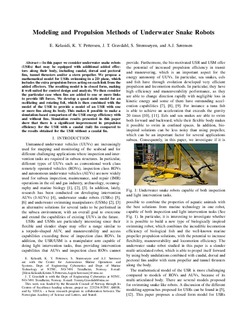| dc.contributor.author | Kelasidi, Eleni | |
| dc.contributor.author | Pettersen, Kristin Ytterstad | |
| dc.contributor.author | Gravdahl, Jan Tommy | |
| dc.contributor.author | Strømsøyen, Simen | |
| dc.contributor.author | Sørensen, Asgeir Johan | |
| dc.date.accessioned | 2018-02-12T13:43:50Z | |
| dc.date.available | 2018-02-12T13:43:50Z | |
| dc.date.created | 2017-10-01T18:56:42Z | |
| dc.date.issued | 2017 | |
| dc.identifier.isbn | 978-1-5090-2181-9 | |
| dc.identifier.uri | http://hdl.handle.net/11250/2484170 | |
| dc.description.abstract | In this paper we consider underwater snake robots (USRs) that may be equipped with additional added effectors along their body, including caudal, dorsal and pectoral fins, tunnel thrusters and/or a stern propeller. We propose a mathematical model for USRs swimming in a 2D plane, which includes the extra propulsion forces acting on each link from the added effectors. The resulting model is in closed form, making it well-suited for control design and analysis. We then consider the particular case when fins are added to one or more links to provide lift forces. We develop a quasi-static model for an oscillating and rotating foil, which is then combined with the model of the USR to provide a model of an USR with one or more fins along its body. This makes it possible to make a simulation-based comparison of the USR energy efficiency with and without fins. Simulation results presented in this paper show that there is a significant improvement in propulsion efficiency for the USR with a caudal (tail) fin compared to the results obtained for the USR without a caudal fin. | nb_NO |
| dc.language.iso | eng | nb_NO |
| dc.publisher | Institute of Electrical and Electronics Engineers (IEEE) | nb_NO |
| dc.relation.ispartof | 1st IEEE Conference on Control Technology and Applications | |
| dc.title | Modeling and Propulsion Methods of Underwater Snake Robots | nb_NO |
| dc.type | Chapter | nb_NO |
| dc.description.version | submittedVersion | nb_NO |
| dc.identifier.doi | 10.1109/CCTA.2017.8062561 | |
| dc.identifier.cristin | 1501092 | |
| dc.relation.project | Norges forskningsråd: 223254 | nb_NO |
| dc.description.localcode | © 2017 IEEE. Personal use of this material is permitted. Permission from IEEE must be obtained for all other uses, in any current or future media, including reprinting/republishing this material for advertising or promotional purposes, creating new collective works, for resale or redistribution to servers or lists, or reuse of any copyrighted component of this work in other works. | nb_NO |
| cristin.unitcode | 194,63,25,0 | |
| cristin.unitcode | 194,64,20,0 | |
| cristin.unitname | Institutt for teknisk kybernetikk | |
| cristin.unitname | Institutt for marin teknikk | |
| cristin.ispublished | true | |
| cristin.fulltext | preprint | |
| cristin.qualitycode | 1 | |
